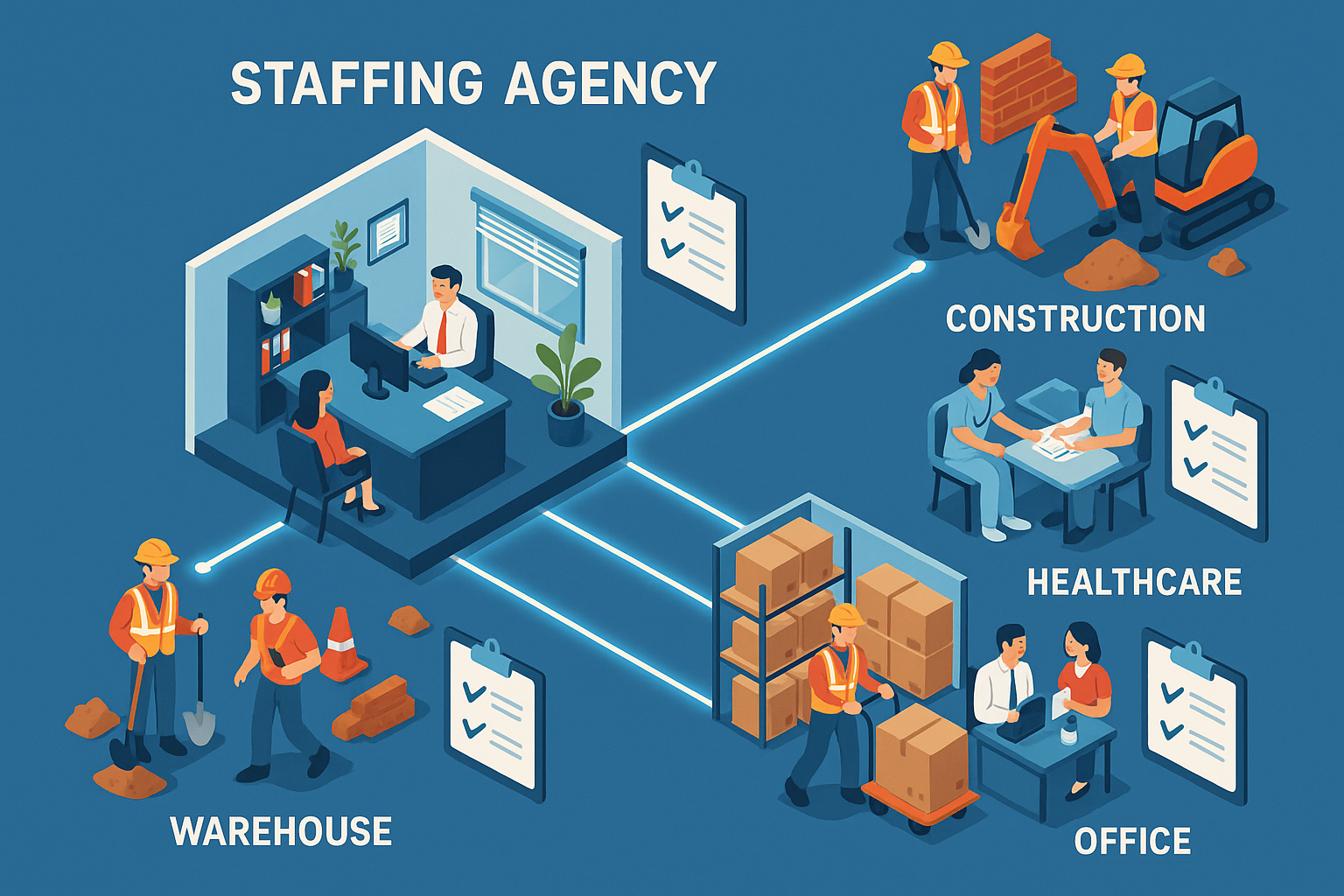Staffing agencies operate in a unique business model where they are responsible for employing workers while assigning them to client companies. This setup creates a complex responsibility when it comes to workers’ compensation insurance. Unlike a traditional employer that has a consistent work environment, staffing firms send employees into a variety of industries—from office roles to high-risk construction jobs. Because of this variability, calculating workers’ comp premiums for staffing agencies requires more precision and oversight than for most businesses. Understanding how these premiums are determined not only helps staffing agencies manage their costs but also positions them to remain compliant, competitive, and profitable.
In this article, we’ll break down the key factors that affect how workers’ comp premiums are calculated for staffing agencies. We’ll also highlight strategies agencies can use to better control these costs while ensuring adequate coverage for their workforce.
The Role of Workers’ Comp in Staffing Agencies
Workers’ compensation insurance provides medical, wage replacement, and rehabilitation benefits to employees who are injured on the job. For staffing agencies, it is especially critical since workers are placed into varied environments where risk factors can differ drastically.
Key points to note:
- Legal requirement: Most states mandate staffing agencies to carry workers’ comp insurance for all employees, regardless of industry placement.
- Client company contracts: Many clients will not engage with a staffing agency unless proof of proper workers’ comp coverage is provided.
- Agency liability: Even though employees are assigned to client businesses, the staffing agency is typically considered the legal employer and bears responsibility for claims.
Staffing agencies must therefore strike a balance between cost management and comprehensive coverage. Premiums represent one of the largest expenses an agency incurs, so knowing what drives them is essential.
The Basic Formula for Premiums
At the core of workers’ comp premium calculation is a formula:
Premium = (Payroll ÷ 100) × Classification Rate × Experience Modifier (MOD) + Fees/Adjustments
Breaking this down:
- Payroll: Total wages of employees, categorized by role.
- Classification rate: Risk-based rate assigned to specific job types, determined by state agencies or rating bureaus.
- Experience modifier (MOD): Adjustment based on the agency’s past claims history compared to industry averages.
- Additional fees/adjustments: Could include taxes, assessments, or insurer-specific charges.
For staffing agencies, applying this formula is more complex because:
- Workers may be spread across dozens of classifications.
- Payroll fluctuates constantly with client demand.
- Claims risk is shared across a large, rotating workforce.
This makes accurate reporting and classification a cornerstone of cost control.
Payroll Reporting and Its Impact
Payroll is the foundation of premium calculation. Because workers’ comp is typically charged per $100 of payroll, precise reporting is crucial.
Factors influencing payroll reporting:
- Frequency of fluctuation: Staffing agencies often see weekly or monthly payroll changes, requiring ongoing adjustments.
- Employee type: Temporary, seasonal, or long-term placements all affect payroll differently.
- Job roles: Each employee must be tied to the correct classification code.
Example:
| Employee Role | Payroll Amount | Classification Code | Rate per $100 Payroll | Premium Contribution |
| Office Clerk | $50,000 | 8810 | $0.30 | $150 |
| Warehouse Worker | $120,000 | 8292 | $6.50 | $7,800 |
| Construction Laborer | $80,000 | 5645 | $15.20 | $12,160 |
This table shows how different employee types dramatically alter the total premium. Even small errors in payroll reporting can result in large cost discrepancies.
Classification Codes and Risk Ratings
One of the most significant drivers of workers’ comp costs is the classification system. Each job is assigned a classification code that reflects its risk level.
- Low-risk roles (e.g., clerical, sales): Lower rates due to minimal exposure to injury.
- Medium-risk roles (e.g., warehouse, drivers): Moderate rates.
- High-risk roles (e.g., construction, healthcare aides): Highest rates due to frequent injury potential.
Challenges for staffing agencies:
- Employees may work across multiple job categories.
- Misclassification can lead to underpayment (causing audits and penalties) or overpayment (unnecessarily high premiums).
- Staffing firms must carefully align job descriptions with official classification codes from organizations like NCCI (National Council on Compensation Insurance).
Example classification rate differences:
- Clerical (Code 8810): $0.30 per $100 payroll
- Healthcare aide (Code 8835): $6.50 per $100 payroll
- Roofer (Code 5551): $20.00 per $100 payroll
Accurate classification ensures fairness and cost control.
The Role of Experience Modification Rate (MOD)
The Experience Modification Rate (MOD) compares an agency’s claims history to industry averages. It acts as a multiplier:
- MOD = 1.0 → Average claims experience
- MOD < 1.0 → Better-than-average claims history (discount)
- MOD > 1.0 → Worse-than-average claims history (surcharge)
For example:
- Agency A (MOD 0.80): Pays 20% less on premiums.
- Agency B (MOD 1.25): Pays 25% more on premiums.
Since staffing agencies often manage large workforces with varied risks, their MOD can swing significantly depending on claim frequency and severity. Strong safety programs and effective return-to-work policies are critical for maintaining a favorable MOD.
State-Specific Regulations
Workers’ comp insurance is regulated at the state level, meaning staffing agencies operating in multiple states face additional complexity.
Key variations include:
- Monopolistic states: Some states (e.g., Ohio, Washington, North Dakota, Wyoming) require agencies to purchase coverage through a state fund.
- Rate differences: Premium rates for the same classification may differ across states.
- Coverage thresholds: The number of employees required to trigger mandatory coverage varies by state.
Example:
| State | Coverage Requirement | Example Rate for Clerical (per $100 payroll) |
| California | 1+ employees | $0.40 |
| Texas | Optional (but recommended) | $0.28 |
| Florida | 4+ employees (construction: 1+) | $0.35 |
Staffing agencies must stay compliant in every state they operate in, often juggling multiple insurance policies or endorsements.
The Impact of Employee Turnover
High turnover is common in the staffing industry, but it complicates workers’ comp premium calculation.
Effects include:
- Constant reclassification: New employees may enter different job categories.
- Payroll fluctuation: Premiums must be adjusted frequently to match real payroll levels.
- Claims volatility: A steady stream of new hires increases the risk of claims since inexperienced workers are statistically more prone to accidents.
Strategies to mitigate turnover impact:
- Comprehensive onboarding and safety training.
- Careful screening and placement of workers into suitable roles.
- Partnering with insurers experienced in handling staffing agency dynamics.
Loss Control and Safety Programs
One of the most effective ways to control premiums is through strong loss prevention.
Safety programs may include:
- Training modules tailored to each industry placement.
- Partnerships with client companies to ensure safe work environments.
- Return-to-work programs that help employees transition back quickly after injuries.
- Regular site visits and audits to assess workplace safety.
Benefits of strong loss control:
- Fewer claims → lower MOD.
- Demonstrated safety commitment → insurers may offer discounts.
- Reduced downtime and improved client satisfaction.
Example: A staffing agency that reduces claims frequency by 20% could see its MOD drop significantly, resulting in thousands of dollars in premium savings.
Premium Audits and Adjustments
Insurance carriers typically conduct annual audits to reconcile estimated premiums with actual figures.
During an audit, insurers review:
- Payroll records
- Employee classifications
- Claims history
Potential outcomes:
- Refund if the agency overpaid.
- Additional charges if the agency underreported payroll or misclassified employees.
To prepare:
- Keep organized payroll and classification records.
- Communicate regularly with insurers to update workforce changes.
- Use software or third-party administrators to streamline reporting.
Regular internal audits can also help prevent costly surprises during insurer audits.
Strategies to Reduce Premiums
While premiums are a necessary expense, staffing agencies have options to manage and even reduce costs:
- Accurate employee classification: Avoid misclassifications that lead to inflated premiums.
- Implement robust safety programs: Reduce claim frequency and severity.
- Leverage pay-as-you-go policies: Align premium payments with actual payroll rather than estimates.
- Maintain clean claims history: Prioritize return-to-work programs and strong claims management.
- Partner with experienced brokers: Work with specialists like Redvo who understand staffing complexities.
Checklist for reducing costs:
- Review payroll and classifications quarterly
- Conduct safety training monthly
- Audit claims management processes annually
- Explore state-specific coverage options
Working with a Specialist Broker
Given the complexity of workers’ comp for staffing agencies, partnering with an experienced broker is often the most effective strategy.
Benefits of working with Redvo Workers Comp Brokers:
- Industry expertise: Deep understanding of staffing industry risks.
- Custom solutions: Tailored coverage for multiple job classifications.
- Cost efficiency: Access to competitive rates and premium-saving strategies.
- Ongoing support: Assistance with audits, claims management, and compliance.
A knowledgeable broker acts not only as an insurance provider but also as a strategic advisor, helping agencies navigate the balance between compliance and cost control.
Final Thoughts
For staffing agencies, calculating workers’ comp premiums is far from straightforward. Payroll fluctuations, high employee turnover, and diverse job classifications all contribute to the complexity. Premiums are influenced by a combination of payroll, classification rates, experience modifiers, state-specific rules, and claims history.
Agencies that take proactive steps—such as maintaining accurate payroll records, investing in safety training, managing claims effectively, and working with a specialized broker like Redvo—can better control costs while ensuring comprehensive protection for their workforce.
Ultimately, workers’ comp premiums should not be viewed as just an unavoidable expense but as a strategic factor that staffing agencies can manage to gain a competitive edge. At Redvo Workers Comp Brokers, we specialize in securing workers’ compensation insurance for businesses across a wide range of industries—including high-risk sectors.



